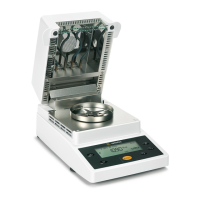15
The proportion of the IR rays which does
not heat the sample is either reflected on
the surface of the sample or penetrates the
sample unimpeded.
The color and surface properties of the
sample significantly influence how effective
the heating process is. For example, dark
substances absorb IR rays better than bright
substances.
IR-Strahlung
Substanz
Wärmeenergie
IR rays
Heat
Substance
Dark substance
Low reflection
Bright substance
Strong reflection
How the rays penetrate the sample depends
on the permeability of the sample. If the
degree of light-transmitting capacity is low,
the rays can penetrate only the uppermost
layers of the sample. The heat conductivity
of the sample dictates the degree to which
the heat can be transmitted to the under-
lying layers. The higher the conductivity,
the faster and more uniformly the
substance is heated.
The substance should be applied to the
sample pan in a thin, even layer. A height
of approximately 2–5 mm for 5–15 g
substance weight has proved to be ideal.
Otherwise, the sample will not be dried
completely or the analysis time will be
unnecessarily extended, a crust/skin will
form on the surface of the sample or the
sample will scorch, and the analysis results
obtained will not be reproducible (and
hence cannot be used).

